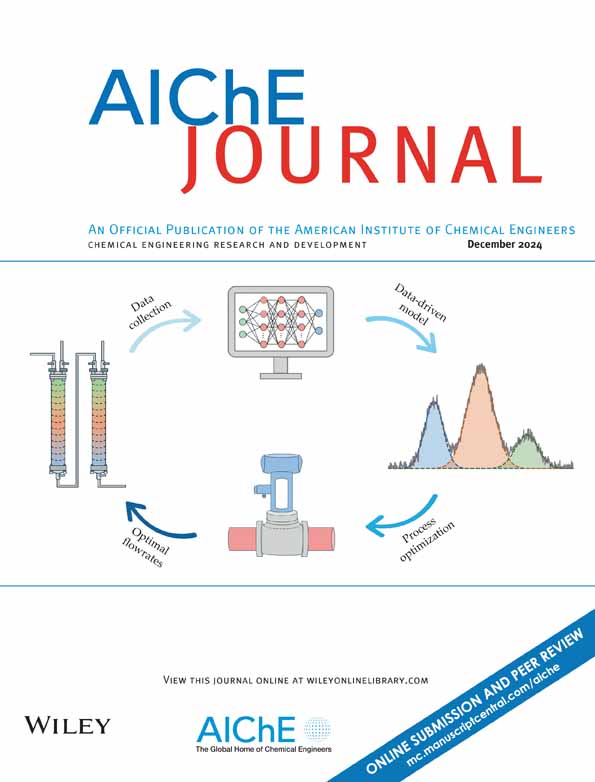金属-有机框架晶体-玻璃复合膜实现CO2/CH4高效分离
IF 3.5
3区 工程技术
Q2 ENGINEERING, CHEMICAL
引用次数: 0
摘要
金属有机框架(MOF)玻璃在气体分离应用中具有很大的前景。然而,MOF玻璃固有的低孔隙率给提高膜透性带来了相当大的挑战。本文采用创新的共混熔融方法合成了一种自支撑型MOF晶体-玻璃复合膜(CGC),将ZIF-62粉末转化为非晶态玻璃相,并将ZIF-9粉末部分熔解,有效地阻止了ZIF-62内部Zn─N键的重组。因此,复合构件结构显著提高了MOF玻璃膜的孔隙率和渗透率。此外,钴在膜基质中的掺入显著增强了其对CO2的吸附亲和力,从而提高了CO2/CH4的选择性。合成的ag[(ZIF-9)0.2/(ZIF-62)0.8]膜具有20,324阻隔的优异CO2渗透率和优异的CO2/CH4选择性,均超过2018年的上限。因此,MOF CGC膜设计的创新策略为气体分离过程中固有的挑战提供了有效的解决方案。本文章由计算机程序翻译,如有差异,请以英文原文为准。
Efficient CO2/CH4 separation achieved by metal–organic framework crystal-glass composite membranes
Metal–organic framework (MOF) glass holds great promise for gas separation applications. However, the inherent low porosity of MOF glass poses a considerable challenge in improving membrane permeability. In this work, a self-supporting MOF crystal-glass composite (CGC) membrane was synthesized via an innovative blending and melting approach, in which ZIF-62 powder was converted into an amorphous glassy phase and ZIF-9 powder was partially flux-melted, effectively preventing the reorganization of Zn─N bonds within ZIF-62. Consequently, the composite component structure significantly enhances the porosity and permeability of the MOF glass membrane. Furthermore, the incorporation of cobalt into the membrane matrix has notably enhanced its adsorption affinity for CO2, thereby boosting CO2/CH4 selectivity. The resultant ag[(ZIF-9)0.2/(ZIF-62)0.8] membrane has demonstrated exceptional CO2 permeability of 20,324 barrer and superior CO2/CH4 selectivity, both surpassing the 2018 upper bound. Thus, the innovative strategy for the design of MOF CGC membranes offers effective solutions to the challenges inherent in gas separation processes.
求助全文
通过发布文献求助,成功后即可免费获取论文全文。
去求助
来源期刊

AIChE Journal
工程技术-工程:化工
CiteScore
7.10
自引率
10.80%
发文量
411
审稿时长
3.6 months
期刊介绍:
The AIChE Journal is the premier research monthly in chemical engineering and related fields. This peer-reviewed and broad-based journal reports on the most important and latest technological advances in core areas of chemical engineering as well as in other relevant engineering disciplines. To keep abreast with the progressive outlook of the profession, the Journal has been expanding the scope of its editorial contents to include such fast developing areas as biotechnology, electrochemical engineering, and environmental engineering.
The AIChE Journal is indeed the global communications vehicle for the world-renowned researchers to exchange top-notch research findings with one another. Subscribing to the AIChE Journal is like having immediate access to nine topical journals in the field.
Articles are categorized according to the following topical areas:
Biomolecular Engineering, Bioengineering, Biochemicals, Biofuels, and Food
Inorganic Materials: Synthesis and Processing
Particle Technology and Fluidization
Process Systems Engineering
Reaction Engineering, Kinetics and Catalysis
Separations: Materials, Devices and Processes
Soft Materials: Synthesis, Processing and Products
Thermodynamics and Molecular-Scale Phenomena
Transport Phenomena and Fluid Mechanics.
 求助内容:
求助内容: 应助结果提醒方式:
应助结果提醒方式:


